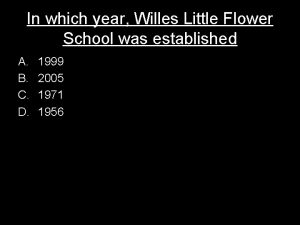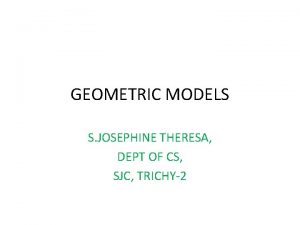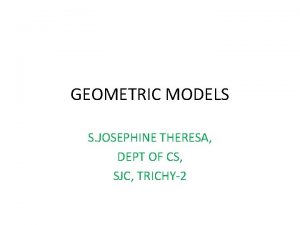COMPUTER GRAPHICS S JOSEPHINE THERESA DEPT OF CS











- Slides: 11

COMPUTER GRAPHICS S. JOSEPHINE THERESA, DEPT OF CS, SJC, TRICHY-2

CONTENTS • • SYMMETRICAL DDA Bresenhams Algorithm Method

The Symmetrical DDA • Digital differential Analyzer • Generates line from their differential equations • To build DDA to draw curves as well as straight lines provided these curves can be defined by ordinary differential equations dy/dx = y/ x

Steps • 1. First derivates x and y • 2. In case of straight line first derivates constant and propotional to x and y • 3. An infinite precision displays we could generate a line incrementing x and y e x and e y. 4. X and y are kept in registers. Registers have two parts integer and fractional

Continuation… • The incrementing values which are both less than unity are repeatedly added to the fractional parts and whenever the results overflows the corresponding integer part is incremented • Fractional parts to achieve rounding(0. 5) value we use DDA

• One advantage of this arrangement , it allows us to detect changes in x and y and hence to avoid plotting the same point twice. • The overflow indicator generated by the DDA produce the signals we need to reposition the point that trace out the line • Symmetrical DDA • 2 n-1<=max(| x| | y|) <2 n

Line drawn with a symmetrical DDA

Bresenhams Algorithm • Line drawing algorithm was developed by bresenhams • Each iterations changes one of the coordinate values +-1 • The other coordinate may or may not change depending on the value of an error term maintained by the algorithm

• The error term record the distance measured perpendicular to the axis of greatest movement between the exact path of the line and the actual dots generated • At each iteration of the algorithm the slope of the line y/ x is added to the error term • A positive e value indicates that the exact path of the line lies above the current point • Therefore the y coordinate is incremented and 1 is subtracted from e • If e is negative the y coordinate value is left unchanged

Algorithm e is real; x, y, deltax, delta y are integers E: = deltay/deltax) -0. 5 For i=1 to deltax do begin Plot (x, y) If e > 0 then begin Y=y+1; E= e-1; End X=x+1; E=e+(deltay/deltax); end;

Continuation…. • • • ADVANTAGES: It is used only integer arithmetic Avoids generating duplicate points It also avoids multiplication and divisions It is well suited to implementation in hardware or simple microprocessors
 Graphics monitor and workstation in computer graphics
Graphics monitor and workstation in computer graphics Lcd working principle ppt
Lcd working principle ppt Josephine mak
Josephine mak Josephine pravinkumar
Josephine pravinkumar Pnv mell
Pnv mell Who is this?
Who is this? Chinese knot tutorial
Chinese knot tutorial Stellenbildung aufgabensynthese
Stellenbildung aufgabensynthese Alpha kappa alpha incorporation date
Alpha kappa alpha incorporation date Who is the protagonist in the story of an hour
Who is the protagonist in the story of an hour Josephine ensign
Josephine ensign Josephine david perry
Josephine david perry





















